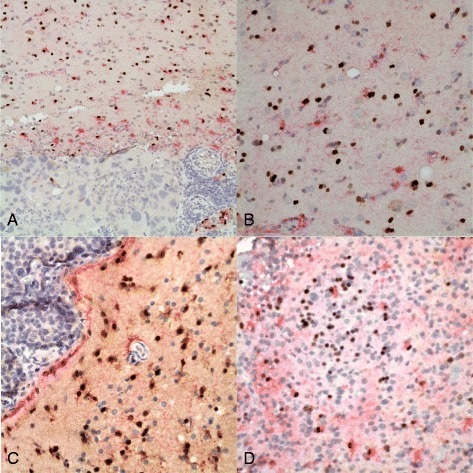Figure 4.

Double-label immunostains for Sox2 (brown, nuclear) and GFAP (red, cytoplasmic) in non-neural CNS tumors. A) Metastatic carcinoma in brain. There is reactive gliosis as indicated by the GFAP-positive cells (with red cytoplasm) at the edges of the neoplasm. Some of these reactive astrocytes have Sox2-immunopositive (brown) nuclei; others do not. There are rare entrapped astrocytes and Sox2-positive nuclei within the tumor. Original magnification 100x. B) Gliotic brain next to a metastatic carcinoma. The three populations of cells described in the text are apparent here: cells with Sox2-immunopositive nuclei without GFAP-immunopositive cytoplasm; reactive astrocytes with GFAP-immunopositive cytoplasm and Sox2-negative nuclei; and cells with double-labeling for both GFAP and Sox2. Rare cells with brown cytoplasm contain melanin and are tumor cells. Original magnification 400x. C) Edge of a metastatic carcinoma in brain. Again there are variably Sox2 and GFAP immunopositive and negative cells as described previously. Original magnification 400x. D) NHL-CNS with double labeling. There are fairly numerous Sox2-immunopositive (brown) nuclei here near the edge of the tumor close to brain (not seen in this image), and a minority of those have associated GFAP-immunopositive (red) cytoplasm. Some reactive astrocytes with GFAP immunoreactivity but no Sox2-immunopositivity are also entrapped among the neoplastic lymphoid cells. Original magnification 400x.
